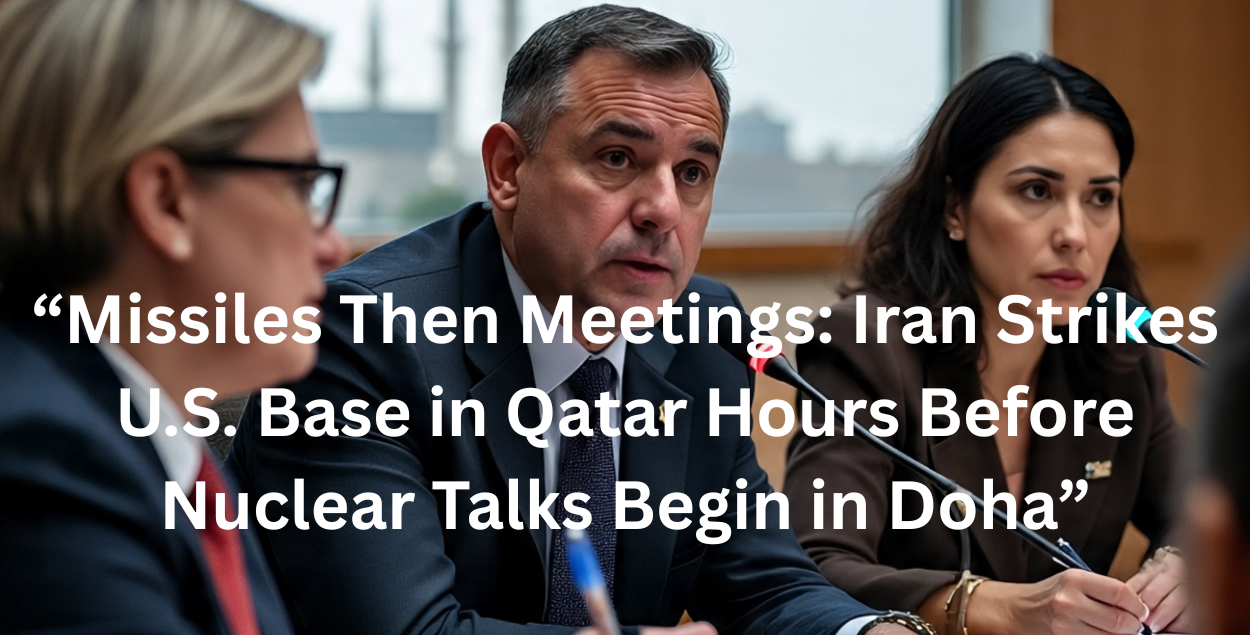FnF News
🇺🇸 FNF News | U.S.–Iran Conflict | Middle East Security Watch
Published: June 27, 2025
By: Khadija Khan, Senior Foreign Affairs Correspondent – FNF
Missiles Before Diplomacy: Iran Strikes U.S. Base in Qatar as Nuclear Talks Begin in Doha
DOHA — Hours before U.S. and Iranian diplomats sat down for what could be the most consequential nuclear talks in a decade, Iran launched 19 ballistic missiles at the U.S.-operated Al‑Udeid Air Base in Qatar—marking a bold shift from retaliation to leverage. The missiles were part of “Operation Glad Tidings of Victory,” Iran’s official response to last week’s U.S. airstrikes on its underground nuclear facilities.
Qatar’s multi-layered defense system—powered by U.S. assets—intercepted 18 of the 19 missiles. One landed near the base’s outer wall, causing no casualties. Still, the symbolism was unmistakable: Iran showed it could strike the U.S. military—then sit across from it at the negotiating table.
Strategic Strike, Surgical Outcome
Iran’s decision to warn Qatar before the attack helped avoid civilian casualties. It also showcased:
- Advanced U.S.-Qatari coordination: Qatar quickly closed its airspace, and Patriot, THAAD, NASAMS, and Rapier systems were deployed in tandem.
- No American troops harmed—but CENTCOM called the strike “a deliberate test of our resolve.”
- President Trump described the attack as “very weak,” insisting it showed Iran’s desperation to re-enter diplomacy.
But inside defense circles, there’s another view: Iran has just demonstrated it can hit American bases across the Gulf—then hold talks without consequences.
Ceasefire Breakdown Before It Began
Just days before the strike, Trump had announced a “phased ceasefire” between Iran and Israel, brokered quietly with help from Qatar and Saudi Arabia. But that deal unraveled almost immediately:
- Israel resumed airstrikes in southern Syria.
- Iran’s proxies activated, with drone launches, cyberattacks, and Hezbollah redeployments near the Lebanese border.
- The Houthis in Yemen have also placed units on “strategic standby,” signaling region-wide risk.
U.S. military officials privately admitted the ceasefire was “DOA—dead on arrival.”
Doha Talks: Diplomacy in the Shadow of War
Despite the rocket fire, negotiations between the U.S. and Iran have officially begun in Doha. The core agenda includes:
- Capping uranium enrichment levels below weapons-grade.
- Reinstating IAEA inspectors to Fordow, Natanz, and Isfahan.
- Discussing phased sanctions relief—primarily for frozen oil revenue and medical imports.
- Establishing a future de-escalation mechanism to avoid further Gulf confrontations.
Iran’s parliament, however, voted last week to suspend IAEA cooperation, casting doubt on Tehran’s sincerity.
Gulf Tensions & Regional Fallout
- Qatar, UAE, Bahrain, and Kuwait closed airspace during the strike window.
- Qatar Airways rerouted over 90 flights and rebooked thousands of passengers.
- U.S. Carrier Strike Groups Gerald R. Ford, Carl Vinson, and Nimitz remain deployed across the Red Sea and Gulf waters, with heightened alert.
Meanwhile, U.S. Cyber Command confirmed a spike in Iranian-linked cyber probing of military and energy networks.
Oil Markets Hold—For Now
Brent crude prices dropped nearly 7% after the missile strike, closing below $72/barrel. Market analysts say confidence in Gulf missile defenses and U.S. strategic oil reserves is keeping panic at bay—but warn that any failure of diplomacy could flip sentiment overnight.
Iran’s Message: Strike, Then Sit
Supreme Leader Ayatollah Khamenei publicly praised the missile attack, calling it a “heavy slap to America’s face.”
Yet Iranian foreign ministry officials signaled openness to continued dialogue—if Iran’s sovereignty and economic lifelines are respected.
That duality is Tehran’s current strategy: fire enough to prove strength, stop short of total war, then negotiate with leverage.

